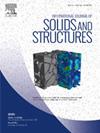Green’s functions of size-dependent Timoshenko beams: Gradient elasticity versus stress-driven nonlocal theories
IF 3.4
3区 工程技术
Q1 MECHANICS
International Journal of Solids and Structures
Pub Date : 2025-02-22
DOI:10.1016/j.ijsolstr.2025.113308
引用次数: 0
Abstract
In this article, Timoshenko elastic nano-beams modeled by three different models (stress-driven nonlocal integral model, strain gradient elastic model without transversal strain gradient, and strain gradient elastic model with transversal strain gradient effect) are analyzed by the help of Green’s function method. Conventionally, the governing boundary value problem (BVP) for Timoshenko nano-beams consists of two differential equations (DEs) and six boundary conditions (BCs) with two unknown dependent variables, i.e., (1) the cross-sectional rotation function, and (2) the transverse displacement field. In the stress-driven model, this multi-field problem is converted into a new single-field BVP including a single higher order DE with only one dependent variable. Obviously, this recent problem needs some new BCs which are rigorously derived in the second step of formulation. The third, and in fact, the last step of the proposed formulation is to solve the new organized BVP by the means of Green’ function. However, in the strain gradient model, the BVP consists of two six-order DEs with two unknown functions. Also, this problem includes twelve boundary conditions which eight of them are “decoupled” and four of them are “coupled” which should be solved simultaneously. To the best of knowledge to the researchers, the current study is a first successful attempt to solve a BVP with some “coupled” boundary conditions by Green’s function. As an instance, the Green’s function of simply supported Timoshenko nano-beams is obtained for both (1) stress-driven nonlocal integral model, and (2) strain gradient elastic model which, respectively, contain symmetric and non-symmetric kernels. Alongside the graphical presentation of the Green’s functions, the results of all models are presented for several loading including the distributed loads expressed by the help of polynomials with higher degrees (equal or more than two) and sinusoidal distributed loading.
求助全文
约1分钟内获得全文
求助全文
来源期刊
CiteScore
6.70
自引率
8.30%
发文量
405
审稿时长
70 days
期刊介绍:
The International Journal of Solids and Structures has as its objective the publication and dissemination of original research in Mechanics of Solids and Structures as a field of Applied Science and Engineering. It fosters thus the exchange of ideas among workers in different parts of the world and also among workers who emphasize different aspects of the foundations and applications of the field.
Standing as it does at the cross-roads of Materials Science, Life Sciences, Mathematics, Physics and Engineering Design, the Mechanics of Solids and Structures is experiencing considerable growth as a result of recent technological advances. The Journal, by providing an international medium of communication, is encouraging this growth and is encompassing all aspects of the field from the more classical problems of structural analysis to mechanics of solids continually interacting with other media and including fracture, flow, wave propagation, heat transfer, thermal effects in solids, optimum design methods, model analysis, structural topology and numerical techniques. Interest extends to both inorganic and organic solids and structures.

 求助内容:
求助内容: 应助结果提醒方式:
应助结果提醒方式:


